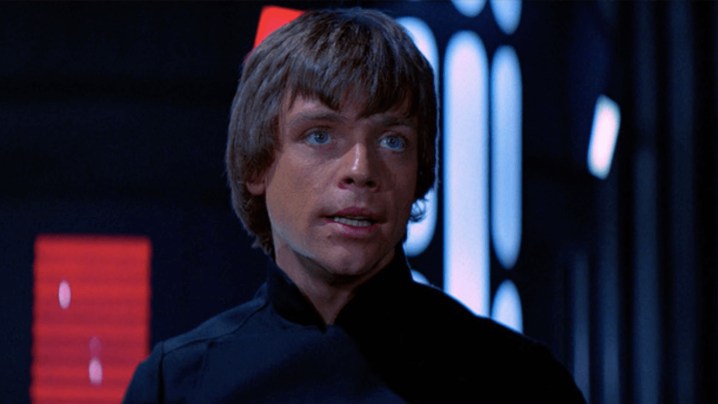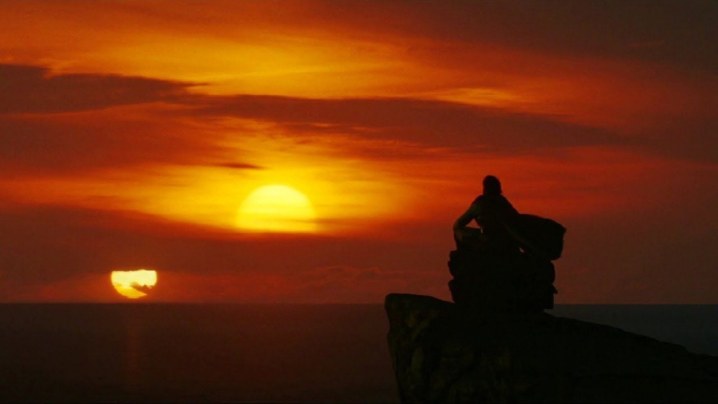It’s been almost five years since Rian Johnson’s The Last Jedi split the increasingly brittle Star Wars fandom, mainly over the way that the movie represents Luke Skywalker (Mark Hamill). For a vocal segment of the fan base, the original last Jedi (Luke) wasn’t an action hero enough in the movie, choosing instead to be a conscientious objector in the interminable galactic conflict. Supposedly, his appearance near the end of the second season of The Mandalorian “retconned” this mistake by giving Luke a moment in which he got to slash up stuff with his lightsaber real good, leading some fans to proclaim the return of the “real” Luke.
But like the retconning of The Last Jedi in J.J. Abrams’ detestable The Rise of Skywalker, this moment was another failure of creators to understand George Lucas’ original vision for Star Wars in general, and for Luke in particular. Now, with years of derivative Disney Star Wars content piling up, whisperings across the internet are growing louder that maybe The Last Jedi is a pretty good Star Wars movie after all. Not only is The Last Jedi aesthetically superior to most other Star Wars material in the Disney era, but it’s also much more faithful to Lucas’ themes, particularly regarding the honor of sacrifice. It also completes Luke’s hero’s journey, staying true to the character by reinforcing his Jedi ideals of pacifism, and it’s the most faithful to Lucas’ vision in the Star Wars canon.
Sacrifice in the original Star Wars trilogy

Return of the Jedi (1983) builds to a climactic choice by Luke to not execute Darth Vader, his father, archnemesis, and the source of much of his pain. Spurred on by the evil Emperor Palpatine to vanquish his old man, Luke instead hurls away his lightsaber and proclaims, “I’ll never join you,” even though he knows the Emperor will destroy him. Luke’s choice concludes the arc of his growth over three movies, and is the moment at which he fully accepts his moral responsibility. He recognizes the dire costs his crossing over to the dark side, even for a moment, would have for the galaxy. But he also knows who he is now. He’s not a killer. Human life has value to him, even whatever diminished humanity might remain in Vader. And he’s willing to sacrifice himself for an act of nonviolent resistance.
The scene is the culminating expression of the controlling idea of sacrifice that underpins the original trilogy, which Lucas dramatizes throughout the three movies. In A New Hope, Luke’s Aunt Beru and Uncle Owen are sacrificed so that Luke can break away and join the Rebellion. Later, Obi-Wan Kenobi sacrifices himself to Vader to empower Luke. The Empire Strikes Back teems with sacrifices. Luke abandons his training with Yoda to save Princess Leia and Han Solo. Han risks almost certain death to save Luke in the frigid landscape of Hoth, then is later almost killed in the-carbon freezing chamber. Lando Calrissian leaves Cloud City to save Leia and Chewbacca. In Return of the Jedi, the whole gang goes out of their way to rescue Han from Jabba the Hutt. At the movie’s climax, Luke sacrifices himself to defeat the emperor and save the galaxy.

But Luke’s sacrifice in ROJ is not the final sacrifice. Because Luke had already made the choice in Empire to not join Vader – hurling himself into an abyss instead – it’s not enough to simply repeat his choice in another context, even if the stakes are higher (he has discovered that Leia is his sister and that she is in danger from the Emperor). The viewer needs a final cathartic staging of the theme. This takes the form of Vader’s ultimate sacrifice to save Luke, and the galaxy, and himself from the Emperor.
Lucas needed to dramatize Anakin Skywalker’s arc in the prequels before this became clear –- but the Jedi who returns in the movie is not Luke, but Vader. This solves a longtime mystery because if Luke is the titular Jedi, it’s never clear where he returned from. Lucas may have been confused as well, or, at the very least, still working out his ideas in 1983, because the film was famously titled Revenge of the Jedi right up until its release. Marketing materials with this title were distributed and withdrawn when Lucas decided that Jedi don’t seek revenge. Though this brings up another question: If the return of the Jedi is the return of Darth Vader from his journey to the dark side, was the revenge of the Jedi also meant to be Vader’s revenge against Palpatine, rather than Luke’s revenge against Vader?
It doesn’t matter, because ultimately Vader acts out of love – for his son, perhaps for humanity in general – not vengeance, in dispensing with the Emperor. Return of the Jedi is affecting because it shows that redemption is always possible, right up until the end. No matter how awful we’ve been or how many mistakes we’ve made, the next choice can still be selfless, can still be in the service of good. And that will always matter.
Furthering themes of sacrifice in The Last Jedi

The idea of sacrifice governs The Last Jedi as it did the original trilogy. This is apparent from the opening sequence, in which the Resistance fights the First Order and Paige Tico (Rose Tico’s sister) sacrifices herself to destroy the Dreadnought star destroyer and redeem Poe Dameron’s reckless bombing mission, which has already seen so many resistance casualties. Later, Admiral Holdo sacrifices herself to save the fleet. Finn almost kills himself trying to destroy the battering ram canon. Rose almost sacrifices herself to save Finn, in one of the movie’s most poignant moments, telling him that rather than fighting what they hate, they should start saving what they love. This sentiment echoes back to Vader’s final acts and anticipates Luke’s.
Fans who have complained about the completion of Luke Skywalker’s journey in The Last Jedi fail to grasp Luke’s eventual arc, in terms of what Lucas had in mind for the character initially. It becomes easier to recognize the true duality of the Force, as well as Luke’s conflict over it, when you realize that Lucas originally intended Luke to turn to the dark side at the end of the original trilogy. He didn’t have the nerve to go through with it, so he told that story in Revenge of the Sith. But the evidence is there when Luke almost crosses to the dark side several times in ROTJ, when he gives in to his temptation to kill Palpatine — to strike him down with all his hate — and again when he overpowers Vader, slices his hand off, and almost vanquishes him before coming to his senses.
When Luke tells Jedi apprentice Rey in The Last Jedi that he saw her “raw strength only once before,” he could easily be referring to himself and his own raw strength, which almost tilted the entire galaxy to the Dark Side 30 years earlier. It also explains why Luke considered killing Kylo Ren in the briefest moment of “pure [murderous] instinct.” He has demonstrated this instinct before, not only when he attempts to kill Palpatine, but when he tries to kill himself at the climax of The Empire Strikes Back.
Peaceful resistance is the way of the Jedi

But in Empire, Luke is still a boy, rash and uncomprehending, and his choice to kill himself rather than join Vader is informed by shock, pain and horror, rather than carefully considered principle. By Return of the Jedi, Luke has an adult’s experience and understanding of consequences. He knows what it means to suffer. And he’s developed more empathy — he doesn’t want others to suffer either.
Much of the uproar against the handling of Luke in The Last Jedi surrounds his supposed lack of active heroism, his abandoning of the galaxy when it needed him, his refusal to take up a “laser sword” against the forces of evil. But this is nothing new for him. He attempts peaceful resistance multiple times in Return of the Jedi. From the outset, he attempts to bargain with Jabba the Hutt for Han, rather than just leading an all-out military attack on Jabba’s palace, which he surely could have destroyed with a couple of X-Wings. Later, he uses the Force to peacefully escape being immolated by the Ewoks, rather than violently overpowering them. Shortly after that, he surrenders to the Imperials in the forest, giving up his lightsaber without a fight. He then tells Vader after his capture, and repeats it several times, that he won’t fight him. Finally, he throws away his lightsaber rather than kill Vader, which isn’t just the key moment to understanding his character — but to understanding the character’s understanding of what it means to be a Jedi.

When Luke tosses his lightsaber away and refuses to join the violent action in The Last Jedi, no one who has paid careful attention to his story should be surprised. His character has been set up like this from the beginning. His ultimate triumph is to be able to save the remaining Resistance without raising a weapon or shedding blood — not fighting what he hates, but saving what he loves. We’ve known all along that Luke is willing to sacrifice for the greater good. His actions at the climax of The Last Jedi, performing nonviolent resistance in the face of evil massed against him — while also giving Kylo Ren one last chance to save his own soul — become the ultimate expression of this.
Finally, his dying reverie of the twin suns on Tatooine, towards which he had gazed longingly as a boy, hoping and wishing for purpose and adventure, reminds us that Luke was not just a Jedi, but a flawed and contradictory person. The final vista of the twin suns, bold and glorious, reveal that his nostalgia for them never faded, despite all of Yoda’s entreaties to live in the moment. At heart, Luke was still a young man and a dreamer. Perhaps, then, his greatest sacrifice was to lay low for the greater good when he still wanted to be out among the stars, skywalking.



